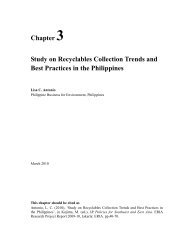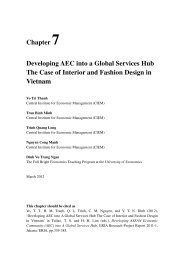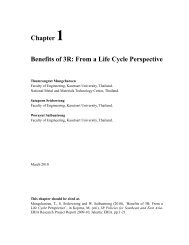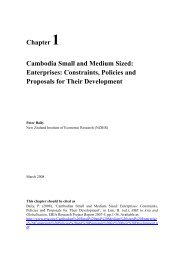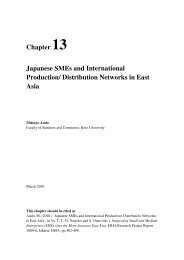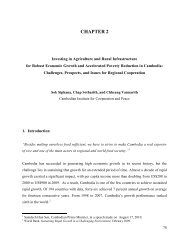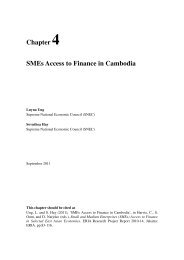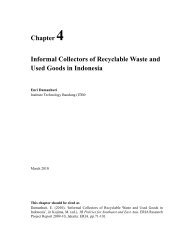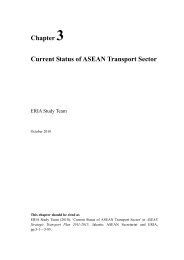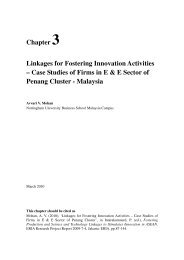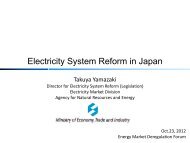Bank Efficiency, Regulation and Response to Crisis of ... - ERIA
Bank Efficiency, Regulation and Response to Crisis of ... - ERIA
Bank Efficiency, Regulation and Response to Crisis of ... - ERIA
You also want an ePaper? Increase the reach of your titles
YUMPU automatically turns print PDFs into web optimized ePapers that Google loves.
estimated. A comparison between this optimal level <strong>of</strong> inputs required <strong>and</strong> the actuallevel <strong>of</strong> inputs each producer uses will yield an efficiency measure for eachdecision-making unit. The output-oriented approach is similar, except that the inputs arekept fixed at the current levels <strong>and</strong> the maximum amount <strong>of</strong> outputs that can beproduced at those levels <strong>of</strong> inputs will be estimated <strong>and</strong> compared against the actuallevels <strong>of</strong> outputs <strong>of</strong> each producer. In the estimation <strong>of</strong> the efficient frontier, eitherconstant returns <strong>to</strong> scale (CRTS) or variable returns <strong>to</strong> scale (VRTS) can be assumed.DEA efficiency scores ranges between 0 <strong>and</strong> 1, with 1 being fully efficient.DEA has several advantages in terms <strong>of</strong> its application <strong>to</strong> the financial sec<strong>to</strong>r. It does notrequire knowledge <strong>of</strong> the explicit functional form or assumptions with regard <strong>to</strong> itss<strong>to</strong>chastic error terms, which is particularly important as it is difficult <strong>to</strong> define thefunctional forms <strong>of</strong> bank production. Nor does it require a large sample size <strong>to</strong>implement. In this study we adopt the input orientation <strong>to</strong> measure the efficiency <strong>of</strong>each bank with the assumptions <strong>of</strong> constant (Input CRS) <strong>and</strong> variable returns <strong>to</strong> scale(Input VRS). As in Berger <strong>and</strong> Mester (1997), DeYoung <strong>and</strong> Nolle (1998) <strong>and</strong> Gonzales(2009), we used three inputs – personnel expenses, book value <strong>of</strong> fixed assets <strong>and</strong>loanable funds (sum <strong>of</strong> deposits <strong>and</strong> non-deposit funds) – <strong>and</strong> two outputs – <strong>to</strong>tal loans<strong>and</strong> non-interest income. In this approach, a frontier is calculated for each individualcountry <strong>and</strong> a bank’s efficiency is measured relative <strong>to</strong> its country’s own frontier (banksare equally weighted).The average bank efficiency measure using DEA for the selected Southeast Asiancountries is given in Table A2 in the Appendix. Indonesia, Malaysia <strong>and</strong> Vietnam haveexperienced low levels <strong>of</strong> bank efficiency among the countries in the sample. In fact, thebank efficiency for Vietnam is lowest among the six Southeast Asian countries whileSingapore <strong>and</strong> the Philippines have the highest. It is interesting <strong>to</strong> notice that thebanking efficiency <strong>of</strong> Malaysia is lower than that <strong>of</strong> Indonesia <strong>and</strong> Thail<strong>and</strong>, <strong>and</strong> is adeclining trend over time except for 1999–2003. It will be interesting <strong>to</strong> examine if thisresult is due <strong>to</strong> the capital controls <strong>and</strong> restrictions on foreign participation imposed byMalaysia since 1998 after the Asian <strong>Crisis</strong>. We also notice that banking efficiency isdeclining for all Southeast Asian banks except for Vietnam. Although the bank295



